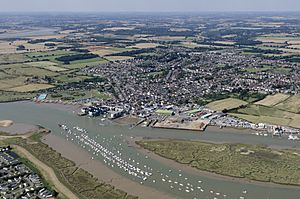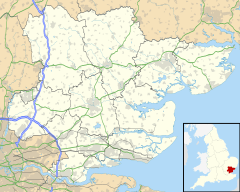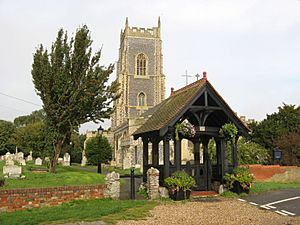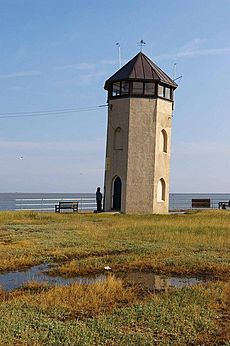Brightlingsea facts for kids
Quick facts for kids Brightlingsea |
|
|---|---|
 Brightlingsea and harbour |
|
| Population | 8,076 (2011 Census) |
| OS grid reference | TM087168 |
| Civil parish |
|
| District |
|
| Shire county | |
| Region | |
| Country | England |
| Sovereign state | United Kingdom |
| Post town | COLCHESTER |
| Postcode district | CO7 |
| Dialling code | 01206 |
| Police | Essex |
| Fire | Essex |
| Ambulance | East of England |
| EU Parliament | East of England |
| UK Parliament |
|
Brightlingsea (pronounced BRY-tling-see) is a town by the sea in Essex, England. It's located between Colchester and Clacton-on-Sea, where the River Colne meets the sea. In 2011, about 8,000 people lived here. Brightlingsea is a busy, though small, port.
The town used to be famous for fishing, especially for oysters, and for building ships. Now, many people who live here travel to work in nearby Colchester.
Brightlingsea is connected to Sandwich, one of the historic group of towns called the Cinque Ports. The town still has special traditions from this connection, like choosing a "Deputy" each year from its Freemen. Brightlingsea used to be twinned with a French town called Marennes, Charente-Maritime, which also fished for oysters. In the 1990s, there were protests in Brightlingsea about animals being sent from the port to other countries. These protests were sometimes called "The Battle of Brightlingsea".
Contents
History of Brightlingsea
Ancient Times in Brightlingsea
Brightlingsea is on a piece of land almost surrounded by water. It was actually an island until the 1500s! People have lived here for a very long time. In 1995, a very old pot from about 4000 to 3100 BC was found near the town. Other old items found in the area date back to the Bronze Age, Roman times, and Saxon times.
Brightlingsea in the Middle Ages
In a very old book from 1086 called the Domesday Book, Brightlingsea (then called Brictesceseia) had about 55 people. The town grew in two main areas: one around the church and another near the shore where a port developed. People traded oysters, fish, and a green pigment called copperas, which was used to make bricks.
The Cinque Port Connection
The Cinque Ports were five important ports on the English coast. They had to provide ships and sailors for the king during wars. In return, they got special benefits, like not having to pay certain taxes. These main ports had "limbs" or smaller ports that helped them. Brightlingsea became a "limb" of Sandwich. It's the only town outside Kent and Sussex with this special connection.
Today, this connection is mostly for ceremonies. Every year, after Saint Andrew's Day, the Freemen of Brightlingsea meet at the church. They choose the "Deputy of Brightlingsea," who represents the Mayor of Sandwich in the town.
Wars Against France (1793–1815)
During the wars against France in the late 1700s and early 1800s, Brightlingsea was a base for sailors called the Essex Sea Fencibles. They helped protect the coast. From 1804 to 1808, Warren's Shipyard in Brightlingsea built 11 gun boats for the Navy. In 1809, a Martello Tower (a small round fort) was built across the water at Point Clear to help defend the area.
The Church of New Jerusalem
Brightlingsea was one of the first smaller towns to have a chapel for the ideas of Emmanuel Swedenborg, a Swedish religious thinker. Their first chapel was built in 1814 and is now a private house. Their second chapel was built in the 1860s. Some local oyster merchants and shopkeepers were early members of this church.
Maritime History
Fishing in Brightlingsea
By the 1790s, Brightlingsea was a busy fishing port. It had many oyster beds and fishing boats. By the mid-1800s, it had more oyster sellers than almost anywhere else in England. Their boats traveled far, even to Northern Holland. However, wars, changes in what people liked to eat, and health concerns about shellfish caused the local fishing industry to decline. No more oysters were raised after 1963, and by the 1980s, there were only a few fishing boats left.
Yachting and Shipyards
Between 1860 and 1939, Brightlingsea was a popular place for wealthy people to store and repair their large steam yachts in winter. Many local men became famous captains of racing yachts. The Aldous Shipyard was very important. It built many fishing boats and did important work for the armed forces in both World Wars. Famous people like Lipton (from the Americas Cup) and the American millionaire Bayard Brown used Aldous's Shipyard.
In 1934, the Aldous Shipyard reopened as Aldous Successors Ltd. It built and repaired many boats for both civilians and the military until 1962. The smaller James and Stone shipyards joined together in 1942 and closed in 1989. These shipyards were the biggest employers in town, with about 800 workers during World War 2. Today, the old Aldous site has boat rental businesses, and the James & Stone site has been turned into flats and a boat marina.
World Wars
During World War I, the Royal Navy had a base in Brightlingsea. They protected the Swin Anchorage, which was used by battleships like HMS Dreadnought. This anchorage was also where the ships started their attacks on Zeebrugge and Ostend in 1918. Brightlingsea also trained ANZAC engineers who were going to the Western Front.
Brightlingsea's naval base was also important in the early part of World War II. It was home to experimental minesweepers. After the Dunkirk evacuation, the base became HMS Nemo. It helped with coastal patrols, air-sea rescue, and was a base for Commando units.
From 1941, local shipyards repaired and equipped motor torpedo boats and other small ships for the Royal Navy. Between 1942 and 1944, parts of Brightlingsea Creek were used as a training area for landing craft. Local shipyards also built small boats for the Royal Navy and RAF, and thousands of pontoons for the British Army.
On January 9, 1941, a German bomber dropped a bomb that hit Tower Street, destroying four houses and damaging eight others. No one was killed, but people were injured. On March 22, 1941, a raid by German fighter-bombers killed two men working in the Aldous shipyard.
Local war heroes included Leslie Frost from the Merchant Navy and fighter pilot Roy Whitehead, who both died during the war.
Protests in Brightlingsea
In 1984, Brightlingsea Wharf was used to bring in coal during the Miners' Strike. Miners from Kent came to protest, and some were arrested by the police.
Brightlingsea became well-known again in the 1990s because of protests against sending live animals from the port to Europe for slaughter. Many people believed the conditions for the animals were cruel. The protests started on January 16, 1995, and ended on October 25, 1995. During this time, over 150 groups of animals passed through the town. Almost 600 people were arrested, and most of them lived in Brightlingsea. The protests stopped the live animal exports, though a ban on British beef exports due to Mad Cow disease (BSE) also played a part.
Landmarks in Brightlingsea
All Saints' Church
The old parish church of Brightlingsea stands on a hill. The oldest parts of the building, like the chancel and parts of the nave, are from the 1200s. More parts were added in the 1400s, including the tall tower, which was finished around 1490. The church has many old memorials. A special feature is a wall with 211 square tiles, each remembering a Brightlingsea person who died at sea between 1872 and 1973. An old map from 1590 shows Brightlingsea Church as a landmark for ships. It is a Grade I listed building, meaning it's a very important historic building.
Bateman's Tower
Bateman's Tower was built in 1883 by John Bateman. He built it for his daughter to recover from tuberculosis, but it might also have been planned as a lighthouse. The tower is at the entrance to Brightlingsea Creek and is sometimes mistaken for a Martello Tower. During World War II, the original roof was removed so the tower could be used as a lookout post. In 2005, the tower was restored to look like it did originally, with a new roof and fresh paint. Today, the Colne Yacht Club uses the tower to help with boat races. It is a Grade II listed building.
Brightlingsea Open Air Swimming Pool
Brightlingsea's open-air swimming pool was built in 1933. It's one of the few lidos (open-air pools, often built in the Art Deco style) still used in the UK. It was originally one saltwater pool but was changed into two freshwater pools in the 1970s: a 50-meter pool for swimmers and a shallower pool for babies. The water is not heated.
Transport in Brightlingsea
The Wivenhoe and Brightlingsea Railway opened in 1866, connecting Brightlingsea to Wivenhoe. This train service stopped in 1964, partly because it cost too much to maintain the swing bridge over Alresford Creek. The swing bridge was removed, and only its stone supports remain today.
Brightlingsea railway station was located where the town's community center is now. It burned down in 1968.
Brightlingsea is almost completely surrounded by water and salt marshes, so it has only one road connecting it to other towns. During the North Sea Flood of 1953, Brightlingsea was cut off, though the town itself wasn't as badly flooded as some nearby places.
Brightlingsea to Alresford Bridge Idea
In 2007, there was an idea to build a new swing bridge over Alresford Creek as part of the Sustrans Connect2 scheme. This would create another way to get in and out of Brightlingsea. However, by December 2020, no further plans or money for this bridge had appeared.
Education in Brightlingsea
Brightlingsea is home to the Colne Community School, a secondary school for students from Brightlingsea and nearby areas like Wivenhoe and Great Bentley. Two former principals of the school, Terry Creissen and Nardeep Sharma, were both awarded an OBE for their work.
Media
You can get local news and TV from BBC East and ITV Anglia. Radio stations include BBC Essex, Heart East, Greatest Hits Radio East, Actual Radio, and Colne Radio, which is a local community station. The town also has local newspapers like Brightlingsea Info, Colchester Gazette, and Essex County Standard.
Sports in Brightlingsea
Brightlingsea Sailing Club has many sailing competitions and has helped train international and Olympic champions. Colne Yacht Club is one of the oldest sailing clubs on the East Coast, started in the 1870s.
Brightlingsea Regent Football Club plays its matches at North Road in the Isthmian League.
Brightlingsea Cricket Club plays in the Two Counties Cricket League and the North Essex Cricket League. They also have a good junior section. All their home games are played at Bayard Recreation Ground.
The Brightlingsea Rugby Club plays its home games at Strangers Corner.
Notable Residents
- Reginald White and John Osborn won Olympic gold medals in sailing in 1976. They both received MBE awards in 1997.
See also
 In Spanish: Brightlingsea para niños
In Spanish: Brightlingsea para niños





